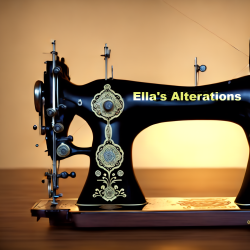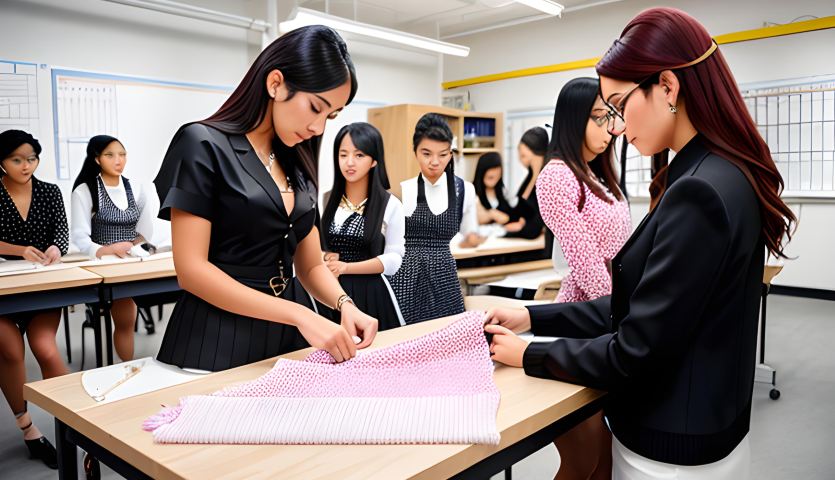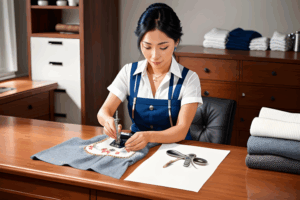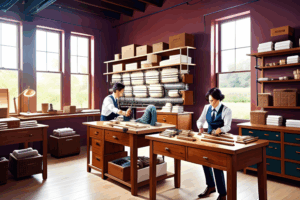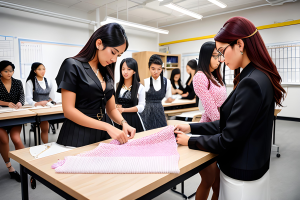Are Seamstresses the Same as Tailors? Unraveling the History behind the Titles | |
IntroductionAre Seamstresses the Same as Tailors? Unraveling the History behind the Titles. In the realm of fashion and clothing production, the terms “seamstress” and “tailor” are often used interchangeably. However, despite their similar roles in the creation and alteration of garments, there are nuanced distinctions between the two. To truly understand the evolution and significance of these titles, we must delve into their historical context. This blog post aims to explore the origins of seamstresses and tailors, shed light on their respective roles, and unravel the fascinating history that has shaped these titles over time. | |
| |
The History of SeamstressesAncient OriginsSewing, the foundational skill of seamstresses, has a rich history that predates recorded civilization. The origins of needle and thread can be traced back thousands of years, with early humans using primitive tools made from bone, wood, or plant materials to stitch together animal skins for protection and warmth. As human societies progressed, so did the art of sewing. Women, as the primary caretakers and homemakers, took on the responsibility of garment production for their families. Sewing became an essential skill passed down through generations, with women gathering in communal spaces to share techniques and knowledge. In these early times, the role of seamstresses was rooted in necessity, as clothing served both functional and aesthetic purposes. They hand-stitched garments using natural fibers, such as linen, wool, or silk, and decorated them with simple embellishments like beads or embroidery. Medieval Guilds and the Rise of SeamstressesDuring the Middle Ages, seamstresses began to form organized groups known as guilds. Guilds were associations that protected the interests and rights of their members, set standards for craftsmanship, and regulated the industry. Seamstresses found solidarity and support within these guilds. They were no longer solely isolated in their homes but gained recognition as skilled artisans. By joining guilds, seamstresses had access to resources, shared knowledge, and opportunities for professional development. The guilds also ensured fair wages and established guidelines for the quality of workmanship. Seamstresses, working collectively, were able to negotiate with clients and maintain a certain level of control over their craft. Industrial Revolution and Changing RolesThe advent of the Industrial Revolution in the 18th and 19th centuries brought about significant changes in the textile and clothing industries. With the introduction of mechanized processes and mass production, the traditional role of the seamstress underwent a transformation. Factories and mills began producing garments on a large scale, utilizing machines that could perform sewing tasks more efficiently. This shift reduced the demand for skilled hand-sewing, and many seamstresses found themselves displaced by industrialization. However, rather than disappearing altogether, seamstresses adapted to the changing landscape. They sought employment in garment factories, where their expertise in sewing and garment construction was still valuable. Seamstresses played a vital role in the burgeoning ready-to-wear industry, contributing to the mass production of clothing. Modern Seamstresses and SpecializationsIn contemporary times, seamstresses continue to play an essential role in the fashion industry, although their roles and areas of specialization have diversified. Here are some notable aspects of the modern seamstress profession: a. Dressmaking and Tailoring: Seamstresses specialize in the creation of custom-fitted dresses, gowns, and other garments. They work closely with clients, understanding their preferences and measurements to ensure an impeccable fit. b. Alterations and Repairs: Seamstresses excel in alterations, modifying existing garments to fit an individual’s body shape. They skillfully adjust hems, take in or let out seams, resize clothing, and mend tears and damages. c. Costume Design: Seamstresses contribute their skills to the world of theater, film, and cosplay, creating unique costumes that bring characters to life. They work closely with costume designers, bringing creativity and technical expertise to their craft. d. Entrepreneurship: Many seamstresses operate as independent entrepreneurs, running their own businesses. They may have their own studios, take custom orders, collaborate with fashion designers, or provide alteration services to the local community. e. Sustainable Fashion: With a growing emphasis on sustainability, seamstresses often play a significant role in upcycling and repurposing old garments. They breathe new life into discarded clothing, transforming them into trendy and eco-friendly pieces. f. Education and Sharing Knowledge: Seamstresses often pass on their expertise through workshops, classes, and online tutorials. They contribute to the preservation of sewing traditions, ensuring that the craft continues to thrive. Next, we will explore the history and evolution of tailors, examining how their specialized skills and craftsmanship have shaped the world of bespoke clothing and alterations.
| |
| Ella’s Alterations LLC 813-445-8894 https://ellasalterations.com | |
The History of TailorsAncient TailoringThe history of tailoring can be traced back to ancient civilizations such as Egypt and Mesopotamia. Skilled individuals known as tailors were responsible for creating custom-made garments, often reserved for the elite and aristocracy. Tailors in ancient times had a deep understanding of garment construction and were known for their precise measurements, intricate cuts, and knowledge of textiles. They worked with luxurious fabrics, incorporating elaborate details and embellishments to create garments that showcased the wearer’s status and taste. The craft of tailoring was closely associated with social status and often involved working directly with clients, taking meticulous measurements, and ensuring a perfect fit. Tailors were revered for their craftsmanship and ability to create garments that accentuated the human form. Medieval Guilds and the Rise of TailorsDuring the Middle Ages, tailors organized themselves into guilds, similar to seamstresses. These guilds served as formal associations that protected the rights and interests of tailors, regulated the trade, and maintained high standards of craftsmanship. Tailoring guilds provided a sense of community and camaraderie among tailors. They allowed for the exchange of knowledge, techniques, and innovations in the field. Guilds also helped maintain quality control by setting standards and guidelines for tailoring practices. The guild system elevated tailoring as a respected profession, and tailors gained recognition as skilled artisans. They honed their expertise in intricate garment construction, pattern-making, and fitting techniques. Tailors played a crucial role in creating garments that were not only aesthetically pleasing but also functional and comfortable. Renaissance and BeyondThe Renaissance period marked a significant turning point for tailoring. The revival of arts and culture brought new developments in fashion, and tailors became essential figures in shaping the trends of the time. Tailors during this era were celebrated for their ability to create garments that flattered the human body. They paid meticulous attention to the proportions, lines, and fit of the clothing. Tailored garments became a symbol of elegance, refinement, and social status. In the 18th and 19th centuries, men’s fashion experienced a surge in popularity. Tailors specialized in creating bespoke suits, meticulously crafting garments that were tailored to each individual’s measurements and personal style. The attention to detail, such as hand-sewn buttonholes and custom linings, became hallmarks of fine tailoring. Tailors TodayIn the modern era, tailors continue to hold a significant place in the fashion industry, combining traditional craftsmanship with contemporary trends. Here are some key aspects of the modern tailor profession: a. Custom-Made Clothing: Tailors excel in creating custom-made clothing for clients, whether it’s bespoke suits, shirts, or formal attire. They work closely with clients, taking precise measurements and incorporating personal preferences to create unique garments. b. Expert Alterations: Tailors possess specialized skills in garment alterations. They can modify off-the-rack clothing to achieve a better fit, alter sleeves, adjust trouser length, and tailor garments to an individual’s specific body shape. c. Suiting and Formalwear: Tailors often specialize in creating tailored suits and formalwear. They pay meticulous attention to every aspect, from fabric selection to pattern-making, to ensure that the final product reflects the client’s style and embodies superior craftsmanship. d. Collaborations and Fashion Design: Tailors may collaborate with fashion designers, lending their expertise in garment construction and pattern-making. They contribute to the realization of unique designs and bring technical precision to the creative process. e. Preservation of Craftsmanship: Tailors play a crucial role in preserving traditional tailoring techniques and passing on their knowledge to future generations. They value the art of tailoring, craftsmanship, and attention to detail, ensuring that these skills continue to thrive. In the next chapter, we will explore the changing landscape and the blurring boundaries between seamstresses and tailors in contemporary times. | |
| Why Alteration Prices Are High. | |
Ella’s Alterations LLC 813-445-8894 https://ellasalterations.com | |
The Changing LandscapeBlurring BoundariesWith the advancement of technology and changes in the fashion industry, the line between seamstresses and tailors has become increasingly blurred. Here are some factors contributing to this phenomenon: a. Technological Advancements: The advent of advanced sewing machines and computerized equipment has revolutionized the industry. Seamstresses and tailors now have access to a range of tools and technologies that enhance their efficiency and capabilities. This has allowed for a convergence of skills and tasks, with professionals adapting to new methods and techniques. b. Diversification of Services: Many modern professionals in the fashion industry engage in a combination of sewing, tailoring, and alteration tasks. Seamstresses may offer tailoring services, while tailors may provide alteration and repair services. This diversification allows them to cater to a broader range of client needs and preferences. c. Customization and Personalization: In today’s fashion landscape, there is a growing demand for personalized garments and unique alterations. Seamstresses and tailors are both involved in fulfilling these requests, employing their skills to create customized clothing that fits and flatters individuals to perfection. The focus is on creating garments that reflect personal style and individuality. d. Collaboration and Cross-disciplinary Work: Seamstresses and tailors often collaborate with fashion designers, stylists, and other industry professionals. Through these collaborations, they exchange ideas, share techniques, and incorporate diverse perspectives into their work. This cross-disciplinary approach contributes to the blurring of boundaries and the evolution of their roles. Empowerment and RecognitionIn recent years, there has been a growing movement to recognize the valuable contributions of seamstresses and tailors. Their skills and craftsmanship are now celebrated, and there is a renewed appreciation for handmade garments and personalized alterations. Here are some factors driving this empowerment and recognition: a. Slow Fashion Movement: The rise of the slow fashion movement has brought attention to sustainable practices, ethical production, and the value of craftsmanship. Seamstresses and tailors, with their ability to create quality, long-lasting garments and perform alterations that extend the life of clothing, are at the forefront of this movement. b. Handmade and Artisanal Appeal: In a world saturated with mass-produced clothing, there is a growing appreciation for the uniqueness and artistry of handmade garments. Seamstresses and tailors, with their hands-on approach and attention to detail, offer a level of craftsmanship that cannot be replicated by machines. c. Body Positivity and Inclusivity: Seamstresses and tailors play a significant role in promoting body positivity and inclusivity in the fashion industry. By offering tailored and custom-made options, they ensure that individuals of all shapes and sizes can have clothing that fits them perfectly, boosting confidence and self-expression. d. Social Media and Online Platforms: The rise of social media and online platforms has provided seamstresses and tailors with a platform to showcase their work, connect with clients, and collaborate with fellow professionals. These platforms have contributed to the visibility and recognition of their skills and craftsmanship. While seamstresses and tailors have historically played distinct roles in the world of fashion, their titles have evolved over time. Seamstresses were primarily associated with sewing and crafting garments, often at a domestic level, while tailors specialized in creating custom-made clothing and undertaking intricate alterations. However, with the changing landscape of the fashion industry, these distinctions have become less pronounced, and many professionals now engage in both sewing and tailoring tasks. Regardless of the evolving terminology, the artistry, skill, and dedication of seamstresses and tailors continue to shape the industry and provide individuals with garments that are tailored to their unique needs and preferences. Next, we will delve into the training and skills required to become a seamstress or tailor, discussing the educational paths, apprenticeships, and ongoing professional development opportunities available in these fields. | |
| |
Training and SkillsEducation and Formal TrainingBecoming a skilled seamstress or tailor often involves a combination of formal education, apprenticeships, and hands-on experience. While there is no strict educational requirement, pursuing relevant training programs can provide a solid foundation for a successful career. Here are some educational paths commonly followed: a. Vocational Schools and Colleges: Many vocational schools and community colleges offer programs in fashion design, sewing, and garment construction. These programs provide students with a comprehensive understanding of fabric, pattern-making, sewing techniques, and garment assembly. b. Fashion Design Programs: Some aspiring seamstresses and tailors choose to pursue formal education in fashion design. These programs offer a broader curriculum that encompasses various aspects of fashion, including design, illustration, pattern-making, and sewing. c. Online Courses and Tutorials: With the rise of online learning platforms, there is a wide range of courses and tutorials available for aspiring seamstresses and tailors. These resources provide flexibility and convenience, allowing individuals to learn at their own pace and gain practical skills from experienced instructors. Apprenticeships and MentorshipsApprenticeships and mentorships play a crucial role in the development of seamstresses and tailors. Learning directly from experienced professionals allows individuals to acquire specialized techniques and gain practical insights into the industry. Here are some avenues for apprenticeships and mentorships: a. Traditional Apprenticeships: In some regions, traditional apprenticeship programs are still prevalent, where aspiring seamstresses or tailors work under the guidance of experienced practitioners. This hands-on training allows apprentices to refine their skills, learn specialized techniques, and understand the nuances of the craft. b. Internships and Work Experience: Internships or work experience opportunities with established seamstresses, tailors, or fashion houses provide valuable exposure to the industry. Working alongside professionals allows individuals to observe and learn from their expertise, while also gaining practical experience in a real-world setting. c. Mentorship Programs: Some organizations and professional associations offer mentorship programs that pair aspiring seamstresses and tailors with experienced practitioners. Mentors provide guidance, support, and industry knowledge, helping individuals navigate their career paths and refine their skills. Key Skills and AttributesTo excel as a seamstress or tailor, certain skills and attributes are essential. Here are some key skills that are highly valued in the industry: a. Sewing and Garment Construction: Proficiency in sewing techniques, understanding patterns, and garment assembly is fundamental for both seamstresses and tailors. This includes skills such as hand-sewing, machine sewing, and the ability to work with different fabrics. b. Precision and Attention to Detail: Seamstresses and tailors must have a keen eye for detail and the ability to work meticulously. Precise measurements, accurate cutting, and precise stitching are crucial to achieve the desired fit and finish. c. Knowledge of Fabrics and Materials: A comprehensive understanding of various fabrics, their properties, and how they behave during the sewing process is essential. This knowledge helps in selecting the appropriate fabric for each garment and understanding how to work with different materials. d. Pattern-Making and Alterations: Seamstresses and tailors should possess skills in pattern-making, as well as the ability to perform alterations and modifications to achieve a perfect fit. This includes taking measurements, adjusting patterns, and making accurate alterations to existing garments. e. Creativity and Design Sense: A sense of creativity and design is valuable for seamstresses and tailors, as they often contribute to the aesthetic aspects of garment construction. They should be able to interpret design ideas, suggest modifications, and add creative embellishments when required. f. Communication and Client Service: Good communication skills are essential for interacting with clients, understanding their needs, and translating their requirements into tangible garments. Seamstresses and tailors should be able to effectively communicate and build strong relationships with their clients. Ongoing Professional DevelopmentSeamstresses and tailors should continue to hone their skills and stay updated with industry trends and advancements. Ongoing professional development ensures that they remain competitive and adaptable in the ever-changing fashion landscape. Here are some ways to continue professional growth: a. Workshops and Continuing Education: Attending workshops, seminars, and continuing education courses allows seamstresses and tailors to expand their knowledge, learn new techniques, and stay updated with emerging trends in the industry. b. Professional Associations and Networks: Joining professional associations and networks provides opportunities for networking, knowledge-sharing, and collaboration with fellow seamstresses, tailors, and industry professionals. These platforms often organize events, conferences, and educational resources. c. Industry Publications and Online Resources: Keeping up with industry publications, fashion magazines, and online resources helps seamstresses and tailors stay informed about the latest fashion trends, sewing techniques, and innovations in the field. d. Experimentation and Personal Projects: Engaging in personal projects and experimentation allows seamstresses and tailors to push their boundaries, explore new techniques, and showcase their creativity. This self-driven exploration contributes to personal growth and the development of a unique style. By acquiring the necessary training, skills, and experience, seamstresses and tailors can establish themselves as professionals in the field and provide high-quality craftsmanship to their clients. In the final chapter, we will discuss the future prospects and challenges for seamstresses and tailors, considering the impact of technology, sustainability, and evolving consumer demands on the industry. | |
| |
| Sustainable Style: Embracing Custom-Tailored Clothing for Ethical Fashion and Unique Wardrobe. | |
ConclusionIn conclusion, while seamstresses and tailors have historically held distinct roles in the fashion industry, the lines between them have become increasingly blurred in contemporary times. Seamstresses excel in sewing, alterations, and garment construction, often working on a domestic or small-scale level. Tailors, on the other hand, specialize in creating custom-made clothing and undertaking intricate alterations. However, the changing landscape, technological advancements, and evolving consumer demands have contributed to the convergence of their roles. Both seamstresses and tailors play vital roles in creating garments that fit well, reflect personal style, and embody superior craftsmanship. Their skills, knowledge, and dedication are essential in fulfilling the diverse needs and preferences of individuals. Whether it’s a seamstress bringing life to a fabric through her sewing expertise or a tailor crafting a perfectly fitted suit, both professions contribute to the artistry and beauty of the fashion industry. As the industry continues to evolve, seamstresses and tailors must adapt, embrace technology, and prioritize sustainability. By staying connected with industry trends, continuously learning, and providing personalized services, they can thrive in an ever-changing market. The future of seamstresses and tailors is promising, with opportunities to showcase their skills, preserve traditions, and contribute to a more sustainable and inclusive fashion world. Remember, whether it’s a seamstress or a tailor, their passion for their craft and dedication to their clients remain constant, ensuring that individuals can wear garments that make them feel confident, comfortable, and stylish. And with that, we conclude our exploration of seamstresses and tailors, shedding light on their history, skills, and the changing landscape of the industry. May their invaluable contributions continue to shape the world of fashion for generations to come. Are Seamstresses the Same as Tailors? Unraveling the History behind the Titles #Seamstresses #Tailors #FashionArtisans #GarmentCreators #NeedleworkExperts #SewingSkills #FabricCraft #PatternMaking #Alterations #CreativeDesign #PrecisionStitching #FashionEducation #Apprenticeships #Mentorships #FashionIndustry #HandmadeFashion #SlowFashionMovement #SustainableFashion #CustomizedGarments #BodyPositivity #InclusiveFashion #FashionTrends #TechnologyInFashion #FashionSkills #ProfessionalDevelopment #FashionWorkshops #FabricKnowledge #FashionDesigners #ArtisanalCraft #FashionCraftsmanship #TextileArt #FashionInspiration #FashionCommunity #FashionCollaboration #FashionCreativity #FashionPassion #FashionForward #FashionInnovation #FashionStyle #FashionCareer #FashionEntrepreneur #FashionAppreciation #EllasAlterationsLLC | |
| |
Ella’s Alterations LLC 813-445-8894 | |
| Vintage Revival Alterations: A Nostalgic Journey for Fashion Enthusiasts | |
|
